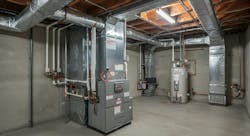Report Finds US HVAC System Market worth $32.35B by 2029
DELRAY BEACH, Florida — The global HVAC system market in the U.S. is expected to be valued at $22.35 billion in 2024 and is projected to reach $32.35 billion by 2029; it is expected to grow at a CAGR of 7.7% from 2024 to 2029, according to a new report by MarketsandMarkets. The HVAC system market is driven by increasing demand for energy-efficient systems due to stricter federal and state regulations for reducing carbon emissions and energy usage.
The Inflation Reduction Act of 2022, for instance, provides incentives for the installation of energy-efficient HVAC systems. Severe weather conditions, such as heat waves and cold snaps, also increase demand for effective heating and cooling systems. The increase in residential and commercial buildings, especially in urban areas, also fuels the demand for advanced HVAC systems. Moreover, the increasing use of smart HVAC solutions, integrated with IoT and AI for improved energy management, attracts consumers. The replacement of HVAC equipment in older buildings is another major driver of market growth. These factors together drive the growth of the HVAC industry in the U.S.
The Heating Equipment Segment is Expected to Grow Fastest During the Forecast Period
The increasing demand for energy-saving and intelligent heating systems, government policies promoting sustainable energy, and increased use of renewable heating technologies drive the demand. Due to severe weather fluctuations and rising energy usage concerns, businesses and consumers are investing in high-efficiency furnaces, heat pumps, and boilers. The shift toward electrification, especially with heat pumps, is gaining momentum because of incentives like federal tax credits and state rebates under programs like the Inflation Reduction Act. Moreover, innovation in smart thermostats and IoT-enabled HVAC systems is enhancing efficiency and fueling market expansion. The growing emphasis on decarbonization is promoting the substitution of conventional gas-fired heating systems with electric ones. In addition, increasing construction activities, both commercial and residential, are also driving demand for heating equipment. The trend toward green building certifications, including LEED, also encourages developers to incorporate high-performance HVAC systems. Furthermore, growth in the industrial and commercial sectors, as well as growing consumer awareness of indoor air quality, is also driving investment in sophisticated heating solutions that provide comfort while reducing operating expenses.
The Commercial Segment is Projected to Grow Significantly During the Forecast Period
High energy efficiency regulations and growing demand for smart and sustainable HVAC solutions fuel the commercial segment. Stringent energy efficiency and sustainability regulations imposed by bodies such as the US Department of Energy (DOE) and the American Society of Heating, Refrigerating and Air-Conditioning Engineers (ASHRAE) are compelling commercial buildings to retrofit their HVAC systems. Rules like the Energy Star certification are promoting businesses to embrace energy-efficient heat pumps, Variable Refrigerant Flow (VRF) systems, and rooftop units that reduce the costs of operation while minimizing carbon footprints. In March 2023, the US government released revised energy efficiency standards for room air conditioners and portable air cleaners, further driving the adoption of sustainable and high-performance HVAC solutions. For example, most LEED-certified commercial properties now incorporate high-performance HVAC solutions to meet sustainability objectives.
The convergence of smart HVAC technologies is revolutionizing commercial HVAC systems. IoT-based systems with AI-driven predictive maintenance, for instance, utilized in intelligent offices and airports, maximize energy usage and enhance indoor air quality. The growing use of automated climate control systems, such as those in hotels and high-rise commercial buildings, contributes to market growth.
The growth in health care and pharmaceutical plants has boosted the demand for high-efficiency air filtration and climate control environments. For instance, in May 2022, Johnson Controls (Ireland) invested $7.5 million in new automation technology at its Norman, Oklahoma factory, enhancing product quality, safety, and assembly productivity.
U.S. is Expected to Grow Significantly Throughout the Forecast Period
The major factors driving the growth of the HVAC system market in the U.S. are the rising demand for energy-efficient and intelligent HVAC systems, government regulations, and growing construction activities in residential and commercial buildings. Extreme weather patterns and an aging infrastructure also drive the demand for HVAC system upgrades and replacements.
The market in the North American region, especially the U.S., is driven by urbanization and rapid infrastructure growth, particularly in smart cities. The increase in data centers and the growth of the healthcare industry also drive demand for precise climate control systems.
The growing popularity of district heating and cooling in cities also influences extensive HVAC implementations. The adoption of HVAC-as-a-Service, through which firms provide leasing and servicing over sales, is on the rise, offering affordable solutions to businesses.
Increased consumer health and wellness awareness has increased demand for HVAC systems with integrated next-generation air purification and humidity control technologies. In addition, supply chain disruptions and volatile raw material prices are compelling companies to invest in localized manufacturing and alternative materials to facilitate market stability.
To find out more, visit www.MarketsandMarkets.com.
